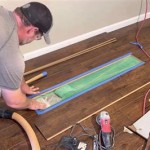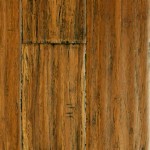Does Vinyl Plank Flooring Need Underlayment On Concrete?
The question of whether to use underlayment beneath vinyl plank flooring installed over concrete is a frequently debated topic in the flooring industry. The answer is not always straightforward and depends on a variety of factors related to the concrete subfloor, the specific type of vinyl plank being used, and the desired performance characteristics of the finished floor. Understanding these factors is crucial to making an informed decision that will ensure a long-lasting, comfortable, and aesthetically pleasing flooring installation.
Concrete, while a durable and stable material, presents several challenges when used as a subfloor for vinyl plank. These challenges include potential moisture issues, unevenness, and a lack of inherent sound insulation. Underlayment can mitigate or eliminate many of these problems, but it is not always necessary or even recommended in every scenario.
To properly assess whether underlayment is required for a vinyl plank installation over concrete, it is important to examine the role of underlayment, the characteristics of concrete subfloors, the types of vinyl plank available, and the implications of foregoing underlayment in certain situations.
Understanding the Role of Underlayment
Underlayment serves multiple purposes when installed beneath vinyl plank flooring, and these functions are particularly relevant when dealing with concrete subfloors. These purposes often include moisture barrier, sound dampening, cushioning, and leveling minor imperfections.
One of the most important functions of underlayment is to act as a moisture barrier. Concrete is a porous material and can transmit moisture from the ground below, particularly if the concrete slab is not properly sealed or if the ground has a high water table. This moisture can damage vinyl plank over time, leading to warping, cupping, and even mold growth. Underlayment with a built-in moisture barrier can help to prevent this moisture from reaching the vinyl plank, extending its lifespan and preserving its appearance.
Another key benefit of underlayment is sound dampening. Concrete is a very dense material and transmits sound readily. This can result in a noisy floor, particularly in multi-story buildings. Underlayment can absorb impact noise and reduce the transmission of airborne sound, creating a quieter and more comfortable environment. The sound reduction properties of underlayment are often rated using an Impact Insulation Class (IIC) and a Sound Transmission Class (STC), with higher numbers indicating better performance.
Cushioning is another advantage offered by underlayment. Vinyl plank flooring is typically quite thin and rigid, and can feel hard and uncomfortable underfoot when installed directly over concrete. Underlayment provides a layer of cushioning that improves the feel of the floor and makes it more comfortable to walk on for extended periods. This can be particularly important in areas where people spend a lot of time standing, such as kitchens and bathrooms.
Finally, underlayment can help to level minor imperfections in the concrete subfloor. While concrete is generally flat, it can have small dips, humps, and cracks. These imperfections can telegraph through to the vinyl plank, creating an uneven surface and potentially damaging the flooring over time. Underlayment can help to smooth out these imperfections and create a more level surface for the vinyl plank, improving its appearance and longevity. However, it is important to note that underlayment is not a substitute for proper concrete subfloor preparation. Significant imperfections must be addressed before installing any flooring.
Characteristics of Concrete Subfloors
The condition and characteristics of the concrete subfloor play a crucial role in determining whether underlayment is necessary. Factors such as moisture levels, flatness, and the presence of cracks or other damage must be carefully assessed before installing vinyl plank flooring.
Moisture testing is essential before installing any flooring over concrete. A simple moisture test can reveal whether the concrete slab is emitting excessive moisture that could damage the vinyl plank. Several methods can be used to test moisture levels, including calcium chloride tests and electronic moisture meters. If moisture levels are too high, it may be necessary to install a specialized moisture barrier or delay the flooring installation until the concrete has dried sufficiently.
Flatness is another important consideration. A perfectly flat concrete subfloor is ideal, but rarely achieved in practice. Minor variations in flatness can be compensated for by underlayment, but significant imperfections must be addressed before installing vinyl plank. Self-leveling compounds can be used to fill in dips and smooth out humps, creating a more level surface for the flooring. A straightedge can be used to identify variations in flatness across the concrete surface.
Cracks and other damage in the concrete subfloor can also pose problems for vinyl plank installations. While minor cracks may not be a major concern, larger cracks or areas of crumbling concrete can weaken the subfloor and cause the vinyl plank to fail over time. These areas should be repaired before installing any flooring. Concrete patch compounds can be used to fill in cracks and repair damaged areas.
Porosity of the concrete should also be considered. A very porous concrete slab may absorb more moisture and require a more robust moisture barrier than a dense, well-sealed slab. The age of the concrete also matters; older concrete may be more prone to cracking and moisture issues compared to newer, properly cured concrete.
Types of Vinyl Plank Flooring and Underlayment Considerations
The type of vinyl plank flooring being used also influences the decision of whether to use underlayment. Some vinyl plank products come with a pre-attached underlayment, while others require a separate underlayment to be installed. The manufacturer's recommendations should always be followed to ensure proper installation and warranty coverage.
Vinyl plank flooring with pre-attached underlayment offers several advantages. It simplifies the installation process, reduces the number of materials required, and ensures that the underlayment is compatible with the flooring. However, the quality of the pre-attached underlayment can vary, and it may not provide the same level of performance as a separate, high-quality underlayment product. It's also crucial to note that pre-attached underlayment does not always compensate for significant subfloor imperfections or high moisture levels.
When using vinyl plank flooring that does not have pre-attached underlayment, the choice of underlayment becomes more important. Several types of underlayment are available, including foam, cork, and rubber. Each type has its own advantages and disadvantages in terms of moisture resistance, sound dampening, cushioning, and cost. Foam underlayment is generally the least expensive option, but it may not provide the best performance in terms of sound dampening or cushioning. Cork underlayment is a more sustainable option that offers good sound dampening and cushioning, but it can be more expensive than foam. Rubber underlayment is the most durable and provides excellent sound dampening and cushioning, but it is also the most expensive option.
The thickness of the vinyl plank is also a factor to consider. Thicker vinyl plank flooring is generally more durable and resistant to damage than thinner flooring. It may also provide some degree of inherent cushioning, reducing the need for a thick underlayment. However, even with thicker vinyl plank flooring, underlayment is still recommended in many situations to provide moisture protection, sound dampening, and leveling.
When selecting an underlayment, ensure it is specifically designed for use with vinyl plank flooring and suitable for installation over concrete. Look for products with a built-in moisture barrier and a suitable thickness for the intended application. Always consult the vinyl plank flooring manufacturer's recommendations for the appropriate type and thickness of underlayment.
Some types of vinyl plank flooring have very specific requirements for underlayment to maintain the warranty. Ignoring these requirements could void the warranty, leaving the homeowner responsible for any future repairs or replacements. Carefully review the warranty information before making any decisions about underlayment.
In summary, the decision to use underlayment beneath vinyl plank flooring over concrete depends on a confluence of factors: the condition of the concrete subfloor, the type of vinyl plank being installed, and the desired performance characteristics of the finished floor. Thorough assessment and careful consideration of these factors are essential for a successful and long-lasting flooring installation.

How To Prepare A Concrete Floor For Vinyl Flooring Parrys

Lvp Flooring Installation Over Concrete Subfloor Full Instructional Builds By Maz Flooret

Do I Need An Underlayment For Vinyl Flooring Lx Hausys

Choosing Underlayment For Vinyl Plank Flooring Your Ultimate Guide Jona Panel S Inc

Do I Need Underlayment For Vinyl Plank Flooring

Vinyl Flooring Does It Need Underlayment Word Of Mouth Floors

Tips For Installing Vinyl Plank Over Concrete Floors Lemon Thistle

Underlayment For Vinyl Plank Flooring Introducing Soundbuffer

Underlayment For Vinyl Flooring The Only Guide You Need Floor City

Do I Need Underlayment For Vinyl Plank Flooring
Related Posts








